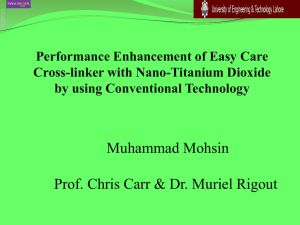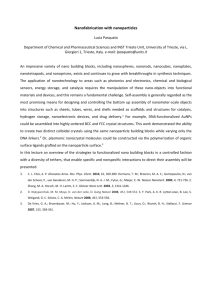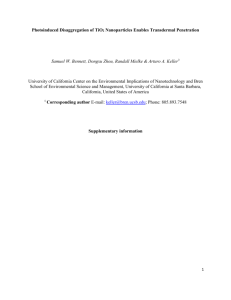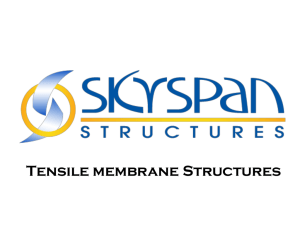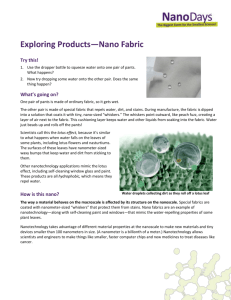Effect of TiO 2 nano-particles on physical and mechanical properties
advertisement
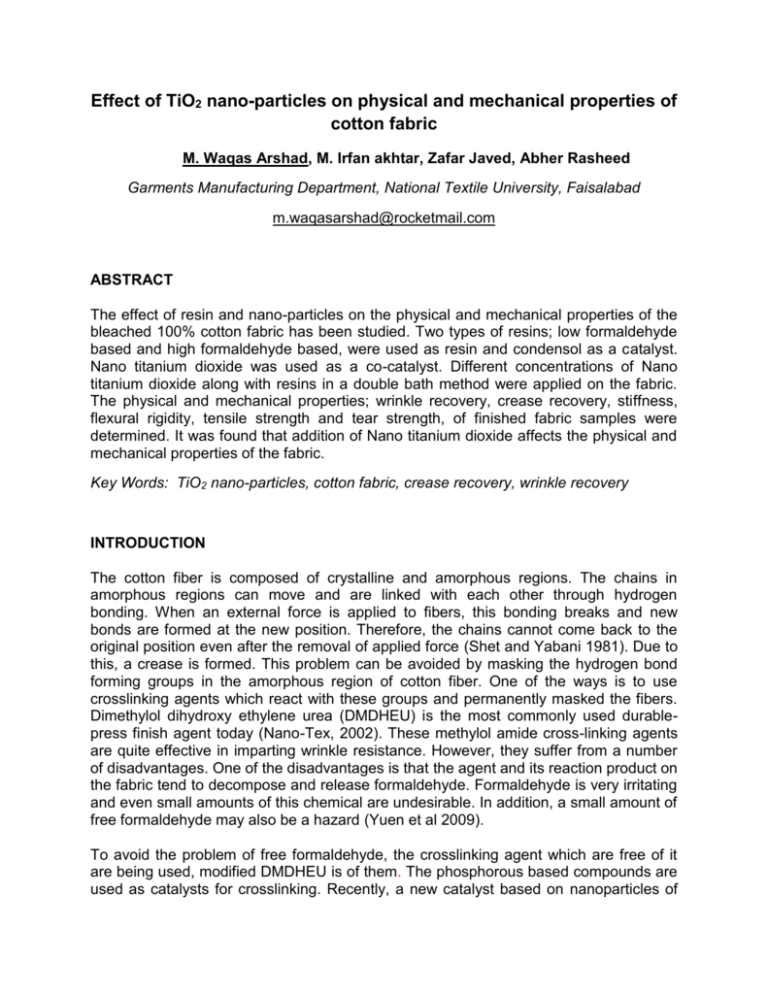
Effect of TiO2 nano-particles on physical and mechanical properties of cotton fabric M. Waqas Arshad, M. Irfan akhtar, Zafar Javed, Abher Rasheed Garments Manufacturing Department, National Textile University, Faisalabad m.waqasarshad@rocketmail.com ABSTRACT The effect of resin and nano-particles on the physical and mechanical properties of the bleached 100% cotton fabric has been studied. Two types of resins; low formaldehyde based and high formaldehyde based, were used as resin and condensol as a catalyst. Nano titanium dioxide was used as a co-catalyst. Different concentrations of Nano titanium dioxide along with resins in a double bath method were applied on the fabric. The physical and mechanical properties; wrinkle recovery, crease recovery, stiffness, flexural rigidity, tensile strength and tear strength, of finished fabric samples were determined. It was found that addition of Nano titanium dioxide affects the physical and mechanical properties of the fabric. Key Words: TiO2 nano-particles, cotton fabric, crease recovery, wrinkle recovery INTRODUCTION The cotton fiber is composed of crystalline and amorphous regions. The chains in amorphous regions can move and are linked with each other through hydrogen bonding. When an external force is applied to fibers, this bonding breaks and new bonds are formed at the new position. Therefore, the chains cannot come back to the original position even after the removal of applied force (Shet and Yabani 1981). Due to this, a crease is formed. This problem can be avoided by masking the hydrogen bond forming groups in the amorphous region of cotton fiber. One of the ways is to use crosslinking agents which react with these groups and permanently masked the fibers. Dimethylol dihydroxy ethylene urea (DMDHEU) is the most commonly used durablepress finish agent today (Nano-Tex, 2002). These methylol amide cross-linking agents are quite effective in imparting wrinkle resistance. However, they suffer from a number of disadvantages. One of the disadvantages is that the agent and its reaction product on the fabric tend to decompose and release formaldehyde. Formaldehyde is very irritating and even small amounts of this chemical are undesirable. In addition, a small amount of free formaldehyde may also be a hazard (Yuen et al 2009). To avoid the problem of free formaldehyde, the crosslinking agent which are free of it are being used, modified DMDHEU is of them. The phosphorous based compounds are used as catalysts for crosslinking. Recently, a new catalyst based on nanoparticles of semiconductor is used to crosslink carboxylic acid based resins. These semiconductors produce electron and hole pair when activated by ultraviolet light. This pair reacts with adsorbed water molecules and oxygen to produce hydroxyl radical and peroxide ions (Zita, Krýsa and Mills 2009, Chen, Wang 2009, Da Silva and Faria 2003, Dastjerdi and Montazer 2011). These species act as catalyst for crosslinking of carboxylic acid based resins. The objective of present work is to study the effect of TiO2 nanoparticles on the crosslinking and wrinkle recovery of modified DMDHEU crosslinking agent. MATERIALS AND METHODS Fabric The fabric used during this research was woven, made of 100% combed cotton. The fabric weight was around 240 grams/m². The warp count and weft count were 17.63 and 22.68 respectively. The fabric was fully bleached, washed and dried. Two resins were used. The first resin had high formaldehyde content (DMDHEU CPF). The second resin was low formaldehyde based (DMDHEU FECP). Condensol was used as a catalyst. Both the resins and the catalyst were given by BASF. Furthermore nano particles of TiO2 were used (Anatase form, 10-12 nm). The particles were provided by the National Center of Physics, Islamabad. In additional to that a non-ionic dispersing agent (Matexil DNVL) was supplied by ICI, Pakistan for the experimentation. There were two variables in our design of experiment; resin type and amount of nano particles. Two levels of resin type (i.e. high formaldehyde and low formaldehyde) and three levels of the amount of nano particles (0g, 0,5g, 1g) were used. The details of the DOE can be seen in table 1. Table 1. Design of experiment Sample no. 1 2 3 4 5 6 Low formaldehyde resin (g/liter) 0 0 0 1 1 1 high formaldehyde resin (g/liter) 1 1 1 0 0 0 Nano TiO2 (g/liter) 1 2 3 1 2 3 Six combinations according to the DOE presented in table 1 were prepared. The details of the recipes are depicted in table 2. Table 2. Details of different recipes used Sample no. 1 2 3 4 5 6 Low formaldehyde resin (g/liter) 0 0 0 100 100 100 high formaldehyde resin (g/liter) 100 100 100 0 0 0 Nano TiO2 (g/liter) 0 0.5 1 0 0.5 1 Non-ionic dispersing agent ( g/liter) 0 2 2 0 2 2 Condensol (g/liter) 20 20 20 20 20 20 Fabric samples of 15x15 inches were cut. The chemicals were applied in two bath process. First bath contained the resin and the Condensol while the second bath had the nano-particles along with the dispersing agent. The samples were first padded, then dried at 120 C° for 3 minutes and finally cured at 150 C° for 3 minutes. The samples were, then, conditioned in the standard conditions of temperature and humidity, for 3 days. Bending length, in both warp and weft, was determined by using a bending length tester. The samples were tested for stiffness according to the standard test method ASTM 1388. The Flexural rigidity was calculated using the bending length and fabric mass per unit area using the equation 1. G = W X C3 Where G (N-cm) is the average flexural rigidity, W (N/cm2) is the fabric mass per unit area, and C (cm) is the bending length. Standard test method AATCC 128 was used to find out the wrinkle recovery of the samples. Wrinkle recovery tester was used for this purpose. In addition to that crease recovery angle was also determined by using CRA (Crease Recovery Angle) tester. Standard test method; AATCC 88C was followed to conduct this test. Furthermore, tensile strength and tear strength of the samples were also calculated by using ASTM D5034 and ASTM D624 respectively. The instruments used were Fabric Tensile Strength Tester and Elmendorf Tearing Tester. RESULTS AND DISCUSSION: Comparison of the resins Experimental results revealed that the flexural rigidity of the samples increases for both the resins. In addition to that crease recovery and wrinkle recovery of the sample was improved for both the resins. On the contrary tear strength and tensile strength were 41.0 40.0 39.0 Low formaldehyde 38.0 high formaldehyde 37.0 36.0 35.0 0 0.5 Crease recovery Flexural rigidity reduced to some extent. Figure 1 represents the Effect of different resins on the cotton fabric properties. 115 110 105 Low f or mal dehyde r esi n 100 Hi gh f or mal dehyde r esi n 95 90 0 1 1200 1000 Low f ormaldehyde resin 800 600 High f ormaldehyde resin 400 200 0 Tensile strength Tear strength 1400 0.5 1 Nano TiO2 (g/l) Nano TiO2 (g/l) 0 0. 5 70 60 50 40 Low f ormaldehyde resin 30 High f ormaldehyde resin 20 10 0 1 0 Nano TiO2 (g/l) 0.5 1 Nano TiO2 (g/l) Figure 1: Effect of different resins on the cotton fabric properties. Effect of nano-particles Bending length of the samples in warp and weft directions was determined. It was found that the Flexural rigidity slightly increases when the concentration of the nano-particles was increased. It means that the fabric gets rigid after the application of the nanoparticles. Infact this is a combined effect of resin and the nano particles. The resin and nano-particles together react with the cellulose which leads to the polymerization, limiting the movement of the cellulose chains. As a result the fabric gets stiffer. Figure 2 shows the Flexural rigidity against the nano TiO2 for both the resins. High form aldehyde resin 50.0 40.0 30.0 Warp 20.0 Weft 10.0 0.0 0 0.5 Nano TiO2 (g/l) 1 Flexural rigidity (N/cm²) Flexural rigidity (N/cm²) Low form aldehyde resin 60.0 50.0 40.0 Warp 30.0 Wef t 20.0 10.0 0.0 0 0.5 1 Nano TiO2 (g/l) Figure 2: Effect of resins and nano TiO2 on the flexural rigidity of cotton fabric. The crease recovery of the samples was improved after the application of resin. The nano TiO2 further improved the crease recovery. Figure 3 depicts the affect of resin and nano-particles on the crease recovery of the samples. Figure 3: Effect of resins and nano TiO2 on crease recovery of cotton fabric. Having very small size, the nano titanium dioxide could fix itself into the non-crystalline regions of the cellulose. Its presence in the fiber’s internal structure restricts the movement of molecules inside the cellulose. That’s why it improves the crease recovery angle of the samples. High formaldehyde resin 1500 1000 warp 500 wef t 0 0 0.5 1 Tear strength Tear strength Low formaldehyde resin 2000 1500 warp 1000 wef t 500 0 0 Nano tiO2 (g/l) 0.5 1 Nano TiO2 Figure 4: Effect of resins nano TiO2 on tear strength of cotton fabric. High formaldehyde resin 100 warp 50 wef t 0 0 0.5 Nano tiO2 (g/l) 1 Tensile strength Tensile strength Low formaldehyde resin 100 80 60 warp 40 wef t 20 0 0 0.5 1 Nano TiO2 Figure 5: Effect of resins and nano TiO2 on tensile strength of cotton fabric. Figure 4 and figure 5 displays the combined effect of the resin and the nano particles on tear strength and tensile strength respectively. The graph shows a continuous reduction in the mechanical strength with the increase of the nano particles. The loss of tensile and tearing strength may be due to the depolymerisation of cellulose molecules. Brittleness of cotton fibers increases due to cross linking effect, that’s why tensile strength is inversely proportional to the rate of cross linking. Tensile and tearing strength decreased with increase in the rate of cross linking. Addition of nano titanium dioxide further reduced the tensile and tearing strength of treated cotton fabrics. This might be due to the inter-fiber and inter-yarn friction . CONCLUSION: Results showed that addition of nano-titanium dioxide in the formaldehyde based resins enhances the wrinkle recovery, and crease recovery of cotton fabrics. Flexural rigidity of the fabric was also increased which will increase the stiffness of the fabric. The application of the resin along with the nano-titanium dioxide reduced the tearing strength, tensile strength of cotton fabric. REFERENCES: Chen, X., Wang, X., & Fu, X. (2009). Hierarchical macro/mesoporous TiO2/SiO2 and TiO2/ZrO2 nanocomposites for environmental photocatalysis. Energy & Environmental Science, 2(8), 872-877. da Silva, C. u. G., & Faria, J. L. Ì. s. (2003). Photochemical and photocatalytic degradation of an azo dye in aqueous solution by UV irradiation. Journal of Photochemistry and Photobiology A: Chemistry, 155(1–3), 133-143. Dastjerdi, R., & Montazer, M. Nano-colloidal functionalization of textiles based on polysiloxane as a novel photo-catalyst assistant: Processing design. Colloids and Surfaces B: Biointerfaces, 88(1), 381-388. Shet, R. T., & Yabani, A. M. (1981). Crease-Recovery and Tensile-Strength Properties of Unmodified and Modified Cotton Cellulose Treated with Crosslinking Agents. Textile Research Journal, 51(11), 740-744. doi: 10.1177/004051758105101110 Yuen, C. W. M., Ku, S. K. A., Li, Y., Cheng, Y. F., Kan, C. W., & Choi, P. S. R. (2009). Improvement of wrinkle-resistant treatment by nanotechnology. Journal of The Textile Institute, 100(2), 173-180. doi: 10.1080/00405000701661028 Zita, J., Krýsa, J., & Mills, A. (2009). Correlation of oxidative and reductive dye bleaching on TiO2 photocatalyst films. Journal of Photochemistry and Photobiology A: Chemistry, 203(2-3), 119-124.
